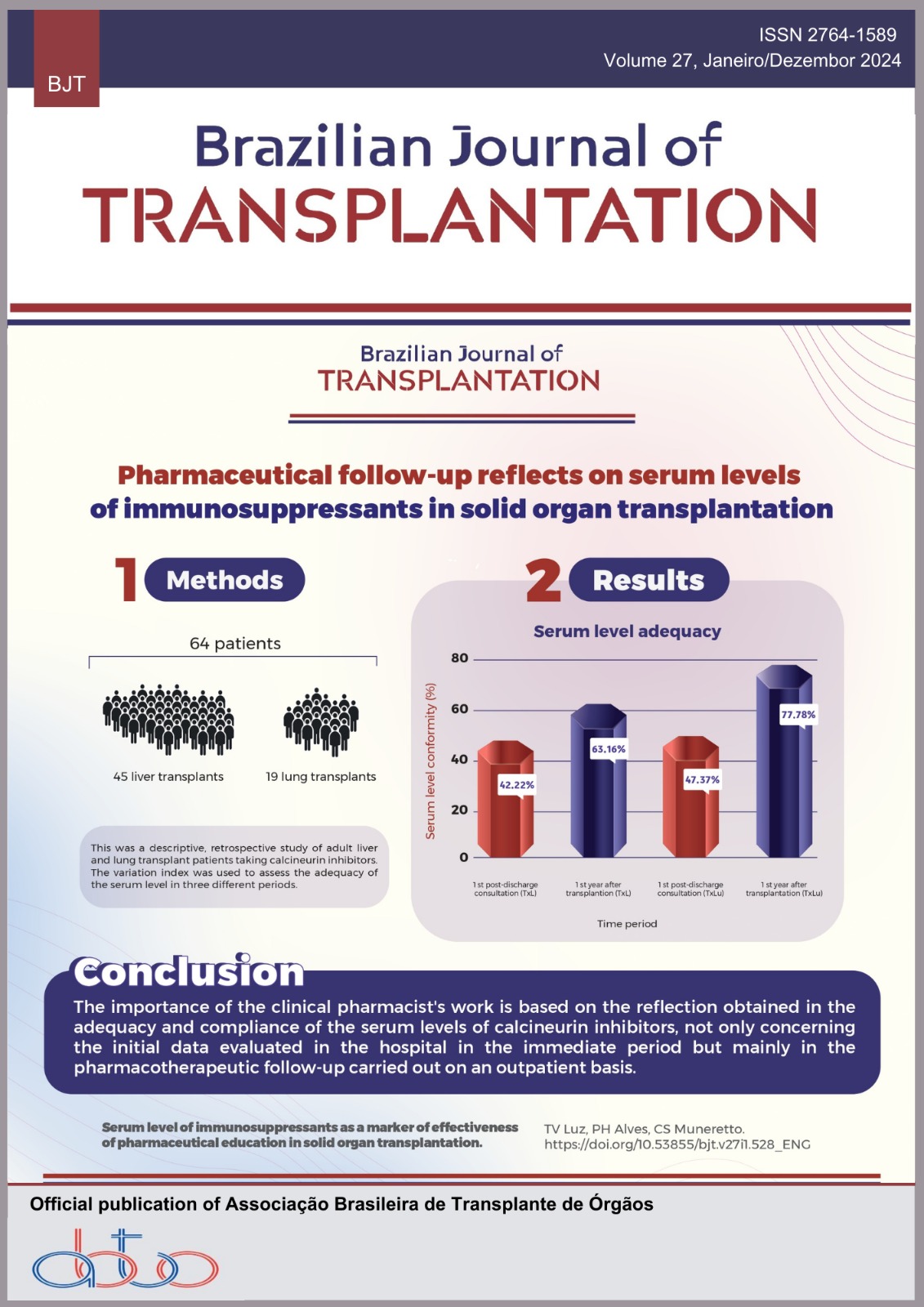Análise de Sobrevida do Enxerto em Pacientes Pediátricos Submetidos ao Transplante Renal
Palabras clave:
Pediatria, Transplante de Rim, Insuficiência Renal Crônica, Análise de SobrevidaResumen
Introdução: O transplante renal . a terapia padr.o ouro para doença renal crônica (DRC) em estágio final. Entretanto, aspectos relacionados às características do doador e do receptor, à técnica cirúrgica, ao protocolo de imunossupressão e comorbidade podem impactar a sobrevida do enxerto. Objetivos: Avaliar os fatores associados à sobrevida do enxerto em pacientes pediátricos submetidos ao transplante renal. Métodos: Estudo descritivo do tipo coorte retrospectivo que incluiu todos os pacientes de 1 a 18 anos submetidos ao transplante renal na Unidade Renal Pedi.trica do Instituto de Medicina Integral Prof. Fernando Figueira (IMIP), Recife, Brasil, de janeiro de 2017 a dezembro de 2021, com tempo m.nimo de seguimento de 10 meses, totalizando 51 pacientes. O estudo foi aprovado pelo Comitê de Ética e Pesquisa do IMIP sob o CAAE: 52023921.1.0000.5201. Resultados: A mediana de idade dos pacientes ao transplante renal foi de 12 anos (9-13), sendo 27 (52,9%) do sexo masculino e oito (15,6%) com menos de 5 anos. As principais etiologias da DRC foram as anomalias congênitas do rim e do trato urinário (n = 25; 49%). Quanto ao transplante renal, 49 (96,1%) foram de doador falecido e a mediana do tempo de seguimento foi de 32 (14-42) meses. Após o transplante, 58% da população eram hipertensos, enquanto 80,4% apresentavam dislipidemia. As taxas de sobrevida do enxerto e do paciente em 5 anos, avaliadas pela curva de Kaplan Meier, foram, respectivamente, 86,3 e 90,2%. Sete pacientes (n = 5) perderam o enxerto, sendo a causa mais frequente a trombose de veia renal. As causas não glomerulares de DRC mostraram menor sobrevida do enxerto quando comparadas .s causas glomerulares (log rank p = 0,010). Conclusão: As taxas de sobrevida do enxerto e dos pacientes em nossa casuística assemelham-se aos dados nacionais e mundiais. As causas mais frequentes de perda do enxerto foram os eventos tromboembólicos. Além disso, observamos elevada prevalência de hipertensão e dislipidemia. Esses resultados nos direcionam para estabelecer estratégias para melhorar a sobrevida nos transplantes renais pediátricos.
Descargas
Citas
Verghese PS. Pediatric kidney transplantation: a historical review. Pediatr Res 2017;81(1-2):259-64. https://doi.org/10.1038/pr.2016.207
Etesami K, Lestz R, Hogen R. Pediatric kidney transplantation in the United States. Curr Opin Organ Transplant 2020;25(4):343-7. https://doi.org/10.1097/MOT.0000000000000783
Keith DS, Vranic G, Barcia J, Norwood V, Nishio-Lucar A. Longitudinal analysis of living donor kidney transplant rates in pediatric candidates in the United States. Pediatr Transplant 2017;21(2):e12859. https://doi.org/10.1111/petr.12859
North American Pediatric Renal Trials and Collaborative Studies. NAPRTCS 2014 Annual Transplant Report [access on 20 Feb 2024]. Available at: https://naprtcs.org/system/files/2014_Annual_Transplant_Report.pdf
Larkins NG, Wong G, Alexander SI, McDonald S, Prestidge C, Francis A, et al. Survival and transplant outcomes among young children requiring kidney replacement therapy. Pediatr Nephrol 2021;36(8):2443-52. https://doi.org/10.1007/s00467-021-04945-9
Souza VC, Garcia CD, Pestana JM, Stopa Martins SB, Custódio LFP, Bittencourt V, et al. Collaborative Brazilian pediatric renal transplant registry (CoBrazPed-RTx): a report from 2004 to 2018. Pediatr Transplant 2019;23(6):e13463. https://doi.org/10.1111/petr.13463
Torricelli FCM, Watanabe A, David-Neto E, Nahas WC. Current management issues of immediate postoperative care in pediatric kidney transplantation. Clinics (São Paulo) 2014;69(Suppl 1):39-41. https://doi.org/10.6061/clinics/2014(sup01)07
Prudhomme T, Mesnard B, Abbo O, Banuelos B, Territo A. Postoperative surgical complications after pediatric kidney transplantation in low weight recipients (<15 kg): a systematic review. Curr Opin Organ Transplant 2023;28(4):297-308.https://doi.org/10.1097/MOT.0000000000001074
Keller AK, Jorgensen TM, Jespersen B. Identification of risk factors for vascular thrombosis may reduce early renal graft loss: a review of recent literature. J Transplant 2012. https://doi.org/10.1155/2012/793461
Beatrice JM, Takahashi MS, Celeste DM, Watanabe A, Koch VHK, Carneiro JDA. Thromboprophylaxis after kidney transplantation in children: ten-year experience of a single Brazilian center. Pediatr Transplant 2021;25(8):e14101. https://doi.org/10.1111/petr.14101
Bapistella S, Zirngibl M, Buder K, Toulany N, Laube GF, Weitz M. Prophylactic antithrombotic management in adult and pediatric kidney transplantation: a systematic review and meta-analysis. Pediatr Transplant 2021;25(4):e14021. https://doi.org/10.1111/petr.14021
Gander R, Asensio M, Royo GF, Molino JA, García L, Madrid A, et al. Vascular thrombosis in pediatric kidney transplantation: graft survival is possible with adequate management. J Pediatr Urol 2018;14(3):222-30. https://doi.org/10.1016/j.jpurol.2018.01.027
Avilez ND, Souza ABP, Domenico BRD, Prates LC, Mazzali M, Lima ML. Analysis of factors related to the success of pediatric kidney transplantation: a 35 years experience. Transplant Proc 2024;56(1):44-9. https://doi.org/10.1016/j.transproceed.2023.11.002
Al Midani A, Rudarakanchana N, Nagra A, Fidan K, Tugtepe H, Matthias M, et al. Low-dose aspirin reduces the rate of renal allograft thrombosis in pediatric renal transplant recipients. Exp Clin Transplant 2020;18(2):15763. https://doi.org/10.6002/ect.2018.0358
Buder K, Zirngibl M, Bapistella S, Nadalin S, Tönshoff B, Weitz M. Current practice of antithrombotic prophylaxis in pediatric kidney transplantation – Results of an international survey on behalf of the European Society for Paediatric Nephrology. Pediatr Transplant 2020;24(7):e13799. https://doi.org/10.1111/petr.13799
Moudgil A, Martz K, Stablein DM, Puliyanda DP. Good outcome of kidney transplants in recipients of young donors: a NAPRTCS data analysis. Pediatr Transplant 2011;15(2):167-71. https://doi.org/10.1111/j.1399-3046.2010.01432.x
Dale-Shall AW, Smith JM, McBride MA, Hingorani SR, McDonald RA. The relationship of donor source and age on short- and long-term allograft survival in pediatric renal transplantation. Pediatr Transplant 2009;13(6):711-8. https://doi.org/10.1111/j.1399-3046.2008.01054.x
Lima MGDR. Curso clínico de uma coorte de pacientes pediátricos submetidos ao transplante renal: uma análise de sobrevida. Thesis [Master in Science Healthy] – Universidade Federal de Minas Gerais; 2012.
Winterberg PD, Garro R. Long-term outcomes of kidney transplantation in children. Pediatr Clin North Am 2019;66(1):269-80. https://doi.org/10.1016/j.pcl.2018.09.008
Mosca S, Gregório B, Costa T, Correia-Costa L, Mota C. Pediatric kidney transplant and cardiometabolic risk: a cohort study. J Bras Nefrol 2022;44(4):511-21. https://doi.org/10.1590/2175-8239-JBN-2021-0202
Ashoor IF, Dharnidharka VR. Non-immunologic allograft loss in pediatric kidney transplant recipients. Pediatr Nephrol 2019;34(2):211-22. https://doi.org/10.1007/s00467-018-3908-4
Mousavi SSB, Valavi E, Aminzadeh M, Shahbazian H, Otukesh H, Hoseini R, et al. Changes in body mass index after pediatric renal transplantation. Saudi J Kidney Dis Transpl 2020;31(2):448-53. https://doi.org/10.4103/1319-2442.284020
Mitsnefes MM, Khoury PR, McEnery PT. Early posttransplantation hypertension and poor long-term renal allograft survival in pediatric patients. J Pediatr 2003;143(1):98-103. https://doi.org/10.1016/S0022-3476(03)00209-9
Ponticelli C, Citterio F. Non-immunologic causes of late death-censored kidney graft failure: a personalized approach. J Pers Med 2022;12(8):1271. https://doi.org/10.3390/jpm12081271
Bock ME, Wall L, Dobrec C, Chandran M, Goebel J. Management of dyslipidemia in pediatric renal transplant recipients. Pediatr Nephrol 2021;36(1):51-63. https://doi.org/10.1007/s00467-019-04428-y
Habbig S, Volland R, Krupka K, Querfeld U, Strologo LD, Noyan A, et al. Dyslipidemia after pediatric renal transplantation – The impact of immunosuppressive regimens. Pediatr Transplant 2017;21(3):e12914. https://doi.org/10.1111/petr.12914
Francis A, Johnson DW, Melk A, Foster BJ, Blazek K, Craig JC, et al. Survival after kidney transplantation during childhood and adolescence. Clin J Am Soc Nephro. 2020;15(3):392-400. https://doi.org/10.2215/CJN.07070619
Amaral S. Secular trends in survival outcomes of kidney transplantation for children: is the future bright enough? Clin J Am Soc Nephrol 2020;15(3):308-10. https://doi.org/10.2215/CJN.00370120
Dierickx D, Habermann TM. Post-transplantation lymphoproliferative disorders in adults. N Engl J Med 2018;378(6):549-62. https://doi.org/10.1056/NEJMra1702693
Descargas
Publicado
Cómo citar
Número
Sección
Licencia
Derechos de autor 2024 Ligia Soeiro, Anna Clara de Moura Lima, Alice Pimentel Vinicius Silva, Maria Eduarda Cardoso de Araújo, Daniela Saraiva Guerra Lopes, Iracy de Oliveira Araújo, Emília Maria Danta Soeiro

Esta obra está bajo una licencia internacional Creative Commons Atribución 4.0.










